Guide to Docking Choices

Whether your property sits on a lake, river, harbor or oceanfront, having a private dock offers a number of advantages to homeowners and businesses alike. Some benefits of owning your own private dock include:
-
-
-
- Convenient access to the water
- No storage or slip fees
- Added security for your watercraft
- Guaranteed slip availability
- Personalized construction and accessories
- Increased property value
- Additional usage for other leisure activities like swimming, fishing, kayaking, socializing with friends, and relaxing
-
-
If you’re ready to enjoy your own personal dock but aren’t sure which type of dock you should choose, let the experts at EZ Dock lend you some advice. Our water experts and enthusiasts are here to help you choose the ideal dock that will let you spend less time on upkeep and more time in the water. Since 1991, we’ve matched boat owners with long-lasting dock systems that meet and exceed their unique watercraft needs.
Determining Your Dock Needs
You need to consider several different factors when determining your dock needs. There are several different types of docks and several material choices. Where you plan to put your dock is another important factor, as things like tides or bottom condition can help determine the best type of dock for your waterfront area. Each different docking system offers benefits; however, certain structures will align with specific needs better than others
Though there are many varieties of docks, each of them can be placed in one of two categories: removable docks and permanent docks. Permanent docks are self-explanatory — they are installed securely into the ground and the structure is intended to remain there permanently. Removable docks are typically intended to be semi-permanent and can be expanded, reconfigured or removed if necessary. The first step is to ask a few questions about your particular location and needs when choosing a dock type.
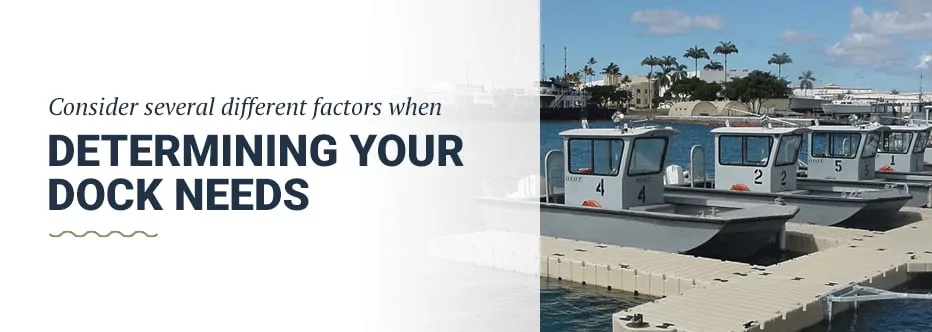
-
-
- What is the depth of the water and condition at the bottom?
- Should the dock be a permanent, adjustable or removable structure?
- How many boats will the dock need to accommodate at once? What about other types of watercraft, such as kayaks or PWC’s?
- Will the water level rise and fall drastically, potentially limiting the dock’s usage?
- Will the dock be exposed to any ice during the winter if the surface freezes?
- What are the surface conditions of the water? Are you in an area that’s prone to heavy boat traffic or frequent storms?
- What is your budget? How much are you willing to put into maintaining the dock?
- Are you planning on installing the dock yourself, are are looking for a dock option that’s DIY-friendly?
-
Whether you’re planning to install a dock in a residential or commercial space, you should take the time to consider how your dock needs may change. For instance, owners of residential properties may choose to install removable docks so that future owners have the option of removing the structure. Similarly, owners of commercial establishments like marinas or restaurants may want to install removable docks for the purpose of future expansion or to easily replace or repair dock sections. There are many advantages to choosing both dock variations.
Types of Removable Docks
Several types of removable docks are available, including the following three:
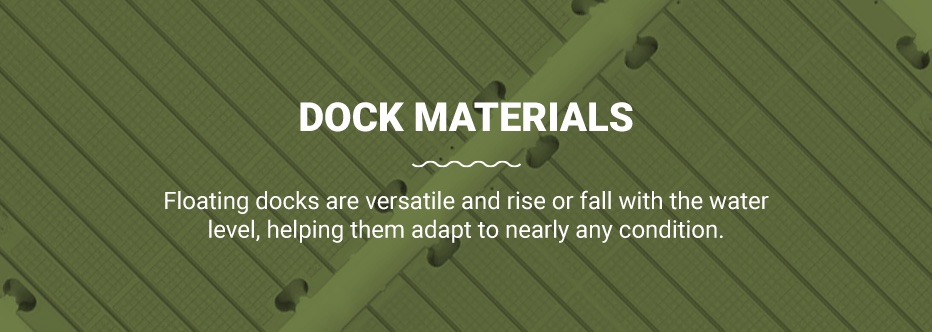
1. Floating Docks
Floating docks are large platforms, often decking placed over airtight drums, that float on the water’s surface. They also are available as pre-built sections that can be attached in a variety of configurations and shapes. Floating dock structures are versatile and rise or fall with the water level, helping them adapt to nearly any condition. They are also ideal solutions for sea, lake or river beds that are unable to support the installation of a fixed dock.
Floating docks are also more practical than other types of docks. They often have fewer permitting requirements because they do not damage sediment. Because they rise and fall with water levels, any critical electrical systems attached to the dock surface will never be submerged. In instances of severe weather or during seasons in which the structure is not in use, floating docks can be hauled away to a safe storage location and easily put back in place when needed. In addition, floating docks can remain in the water all winter in certain instances, such as in locations where there is not a lot of wind or water current that can push the ice against the docks (thus, possibly damaging them).
2. Piling Docks
Piling docks are constructed by inserting large wooden beams called pilings deep into the ground under the water. The dock is then connected to the piling — typically by an attachment that contains hoops, rollers, or both — which will then allow the dock to rise and fall with changing water levels while still maintaining its position in the water. Piling docks are strong and stable, and can withstand strong currents. However, they are expensive to build and maintain, and can’t adjust as water levels change. They work best for larger boats or as a fishing dock.
When choosing a piling dock, it’s imperative that you plan out its construction thoroughly. The success of this dock rests on its structural integrity, so any mistakes or cut corners could ultimately cause thousands of dollars worth of damage. Wood posts could rot if not properly treated, so a fiberglass alternative may be used. You also need to protect the pilings from other destructive organisms and protect the piling caps from harmful UV rays.
3. Pipe Docks
Pipe docks are similar to piling docks but are usually built using an aluminum frame with removable docking. They are less stable than piling docks but also less expensive. This makes them an easy-to-build and cost-effective docking system. Pipe docks work well in shallow water — no more than eight feet — and need to be removed in the fall to prevent freezing from damaging the pipes. Since the surface doesn’t make significant contact with the land or water, it is one of the least environmentally impactful docking options.
A pipe dock is stationary. While floating dock structures can rise and fall with the water level, pipe docks can become submerged easily. It’s recommended that the dock is raised, lowered or relocated in regions where seasonal variations may significantly influence water level or cause the water to freeze over. Though this dock system is initially less expensive, ice and rough currents may damage the piping or surface. Owners should anticipate repairing or replacing the pipes or surface sections occasionally.
Types of Permanent Docks
If you’d rather have a permanent dock, you have two main choices:
1. Crib Docks
Crib docks are made from wooden frames or crates, called cribs, placed along the bottom. These permanent, custom-built wooden frames are then filled with large rocks and covered with decking. Crib docks are very stable and typically very expensive. They basically extend the shoreline and can affect the natural flow of water and disrupt wildlife. Some areas don’t allow crib docks because of this.
A crib dock should last for decades, which makes it a great docking structure for permanent applications. However, those who select this type of dock are trading convenience for stability. Crib docks are intended to be installed for long-term use, which means it cannot easily be removed or extended. Crib docks may also cause long-term environmental problems, like disrupting the water flow along the shoreline, affecting nearby wildlife and causing further issues if a flood were to occur.
2. Suspension Docks
Almost the opposite of crib docks, suspension docks hang over the water via cables and anchorage. These docks have a modern appearance and have much less of an impact on the environment compared to crib docks. Their interesting design may be visually appealing; however, due to the engineering required in its installation, suspension docks are very costly and time-consuming.
Much like crib docks, installing a suspension dock is not a decision that should be made until all factors have been considered. There are some drawbacks that suspension dock owners may not immediately anticipate. For instance, while floating dock structures can be removed during instances of severe weather, suspension docks are stationary and are forced to endure potentially damaging winds or water swells. If the dock is made from wood or aluminum, damaged pieces may cost more to replace than plastic materials.
Dock Materials
Choosing a dock involves much more than simply picking a style that meets your visual expectations. As described, there are many features of both fixed and floating docks that make each suitable for a particular application. The type of material used to construct the dock should be another critical consideration when designing your new or replacement dock. To make the best decision for your water-side structure, you should examine factors including initial cost, durability, upkeep, damage risks and environmental impact.
Thankfully, you have options when it comes to building both a floating and fixed dock. Wood, aluminum and plastic are three popular boat dock decking materials you’ll likely consider. Though all three can provide watercraft owners with a sturdy and reliable platform for launching watercraft, not all materials have similar benefits. The differences between the three impact everything from long-term operating and ownership costs and maintenance responsibilities to the way these materials may potentially cause harm to the environment and those who use the dock.
1. Wood Docks
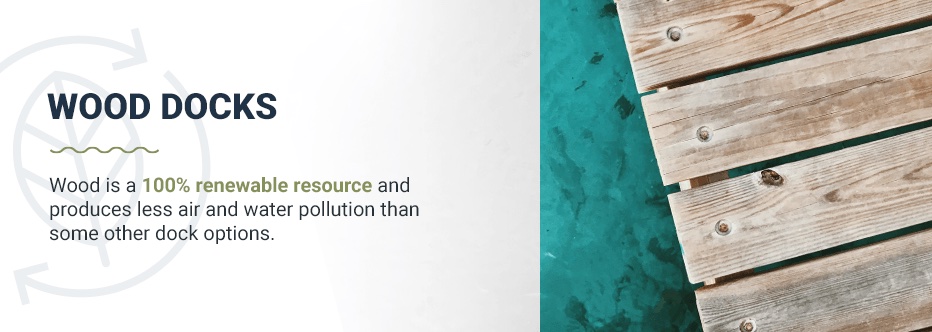
Some may picture a traditional wooden dock for their property and it’s easy to see why. For those who prefer a natural look, wood is aesthetically pleasing. Though wood is a traditionally well-known boat dock decking material, it does have several drawbacks — including intensive upkeep, a variable lifespan and limited safety hazards. Other factors include:
-
-
- Cost: Prices for new wooden decking materials will vary depending on the actual type of wood used. Cedars and hardwoods could range from $3.50 to $4.36 per square foot to as much as $5.00 to $7.50 per square foot. Though many pressure-treated kinds of wood will also fall into that range, synthetic woods can be as expensive as $35 per square foot. However, if you have an existing older dock that doesn’t have structural damage, you will want to invest in upkeep and maintenance, as restoring it to its former beauty regularly will increase its longevity.
- Insect Damage: Termites aren’t the only threat to wood docks or docks with wood decking — many types of insects can damage untreated wood. Powerpost beetles could be attracted to the dock and decking depending on the area you live in, and nest in untreated wood — which may not begin to show signs of damage until the beetles emerge. Carpenter ants may nest in wood that’s been damaged and begin to tunnel through the structure. Carpenter bees may also bore into wood to lay their eggs.
- Upkeep: Painting and sealing pine or wooden docks is only a temporary solution. Continued exposure to fresh or salt water and rain will cause wood to eventually rot and degrade. Pressure-treated lumber may require constant monitoring and preventative maintenance to stop the wooden components from degrading and ruining the dock. A wood dock may also need to be refinished every two to three years.
- Repairs: Along with becoming a safety hazard, dry-rotted wood replacements could cost you hundreds of dollars. Piling or pipe replacements could cost more, up to as much as $1,600 per piece! However, if you discover minimal rotting or small pitted holes, you can likely repair these areas yourself with wood filler. Other simple fixes to older wooden docks that don’t have major structural damage include fixing loose boards, removing stains and discolorations and replacing loose nails and cracked boards.
- Environmental Considerations: Wood is a 100-percent renewable resource and produces less air and water pollution than some other dock options. However, pressure-treated wood, which is used for dock construction in freshwater and saltwater areas, has the potential to contaminate the water. Because the wood-treating process uses chemicals, all manufacturers of treated wood have to abide by EPA minimum retention-rate standards. Freshwater, pressure-treated lumber has to have a retention rate of at least 0.60 pounds per cubic foot. For saltwater docks, the lumber has to meet a minimum standard of 2.5 pounds per cubic feet.
- Ability to Expand, Reconfigure or Remove: Permanent wooden docks such as piling docks or crib docks are not easily removed. Extending or reconfiguring a piling or crib dock would require significant work. A crib dock is typically a customized structure and would require a customized solution to extend or redesign it to your needs. You also must consider any rules and regulations that your area has regarding the installation of dock additions.
- How Long They Last: A well-maintained wooden dock made with pressure-treated lumber could last between 10 to 20 years. Unfortunately, even with regular maintenance, there’s always a risk of rotting, warping, splitting or splintering. Nails in the wood may also come dislodged over time.
- Safety Hazards: Regarding wood docks, the darker the color of the wood, the more heat it will absorb. Because wood pulls heat deep into the board, the area your feet touch should not be unbearably hot, even in the highest temperatures. This makes choosing a wooden dock surface material preferable to metal. However, one hazard of wooden docks is the threat of splintering. An injury from a wood splinter is an easy way to ruin a perfectly good day on the lake. As wood absorbs moisture, it expands. Then, as it dries out, it contracts. This process can cause the wood to splinter, and splinters can carry bacteria and cause infection. To help minimize the chances of catching a splinter on your deck, you can sand down any split boards or large splinters that you see.
-
2. Aluminum Docks
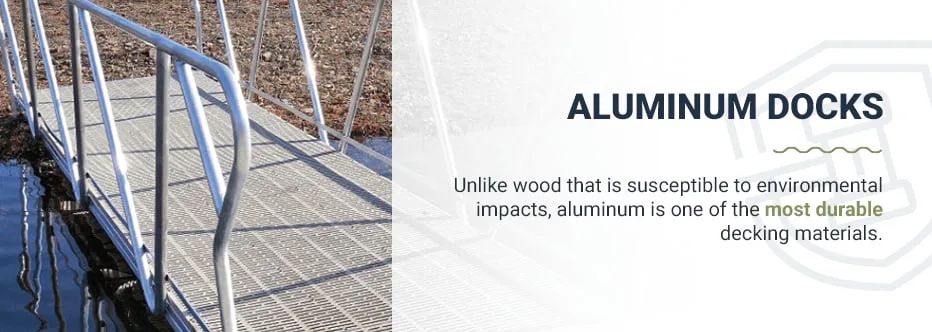
While a traditional wooden dock may spring to mind when considering your options for decking materials, aluminum decking is another option you can consider. Assembled with interlocking edges, aluminum decking planks create a watertight and gapless seal. Some other considerations are:
-
-
- Cost: Typically, aluminum docks are pre-built by the manufacturers and may have a higher initial cost. Aluminum boat dock decking material could cost upwards of $10 dollars per square foot. As a result, it is typically one of the more expensive materials you can choose for your dock.
- Durability: Unlike wood that is susceptible to environmental impacts, aluminum is scratch- and weather-resistant. Aluminum is also as much as four times lighter yet three times stronger than wood.
- Upkeep: Aluminum does not rust, but it will corrode. The corrosion process actually protects the aluminum from rusting. Unfortunately, though you don’t have to worry about rust eating away the metal, you do have to worry about the structural integrity of the dock being compromised. Aluminum becomes dull from corrosion and can become encrusted with everything from calcium and lime to hard-water stains. To clean grime, algae and other hazardous substances off of your aluminum dock, you’ll need to mix water and baking soda into a paste. Use steel wool or a wire brush to clean contaminated spots thoroughly. Then, pressure-wash the entire dock. For saltwater docks, you’ll need to frequently spray them down with plain water to prevent salt corrosion.
- Damage to Boats: Thankfully, aluminum docks are strong enough to resist damage from impact with watercraft. However, as with any vessel that makes contact with a sizeable object, an aluminum dock could cause damage to a boat.
- Repairs: Because aluminum decking will not rot, attract damaging pests or grow mold, repairs are usually minimal.
- Environmental Considerations: Though the mining process and refinement of ore requires a lot of energy, aluminum is heavily recycled. You can reuse uncontaminated aluminum almost indefinitely.
- Ability to Expand, Reconfigure or Remove: Because aluminum docks are typically manufactured in sections for installation, they can be added onto or reconfigured. While permanent structures like wood piling docks cannot be removed easily, aluminum docks can usually be folded and stored when not in use during the winter or seasons with heavy storms.
- How Long They Last: Aluminum decking should stand the test of time. In fact, aluminum frames may last from 30 to 50 years depending on conditions.
-
3. Plastic Docks
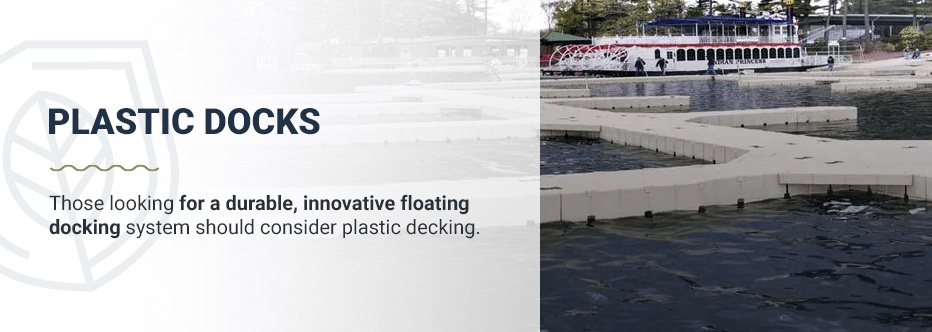
Those looking for a durable, innovative floating docking system should consider plastic decking. This type of dock material is easy to install and can cater to budgets of all kinds. It also represents a great option if you want the durability and longevity of aluminum docks but without the high price tag. While permanent wooden docks may have once been the traditional docking system, they’re no longer the most practical option. A plastic floating dock tends to offer more benefits and fewer drawbacks than wooden and metal permanent docks combined, including the following:
-
-
- Cost: A dock is an investment. For commercial application, you want it to be functional, attractive and able to accommodate your employees or guests. For residential application, you want a dock that is reliable and enjoyable any day of the year. Though you could spend significant amounts of money installing a permanent dock system with high-quality wood or aluminum, you must always consider the overall price of the dock throughout its lifespan. The fact is that price doesn’t always equal value. Fixed docks made from wood or aluminum may cost more in overall ownership, but resin or plastic floating docks can actually save you money in the long run. Their ability to be reconfigured instantly allows you to update your dock as your needs change. They’re also portable, which means your single docking system investment can move with you wherever you go. Most importantly, they’re designed for maximum durability, so you can get the most out of your investment without worrying about excessive repairs or replacement parts.
- Durability: Wood can warp and rot, while metal can dent and rust. Resin decking and plastic docks, however, are made of durable dock surface materials designed to give you more time on the water. In both freshwater and saltwater environments, polyethylene docks won’t rot or splinter like wooden docks. You also don’t have to worry about replacing an entire structure should one part of it incur damage. If a resin or plastic dock section is damaged, it can be easily replaced. There is no worry about damaged posts, piles or pilings either.
- Upkeep: Wooden docks require regular maintenance, and while aluminum docks may not need as much upkeep, they still require an attentive eye for rust, mold or other unfavorable occurrences. Plastic decks are much easier to maintain. Clearing the deck with a simple sweep can help the surface retain its beauty. You can clean it with soap and water and remove stains with deck cleaners and household degreasing agents.
- Damage to Boats: While stationary docks can be secured to the land or floor of the body of water to provide stability, the downside is that water swells, rough waves and other harsh weather can knock your boat or vessel against the dock and cause significant damage. Floating plastic docks can help cause less damage to boats left in the water during hurricanes. Unlike permanent docks that are stationary, floating docks can rise and fall with a surge that will keep the stress on dock lines at a minimum. As the water swells during storms, floating docks can move vertically with the water. When it comes to horiztonal movement, that will be limited by the pilings or pipes — so if you happen to keep your boat in the water during a rough storm, a good set of fenders is likely the best protection when it comes to reducing damage to the boat.
- Repairs: Consider the types of repairs you may have to make on wooden docks. Rotted wood is a significant hazard and any time you have to replace a section, that’s an added cost you didn’t anticipate. More importantly, replacing pilings or pipes could cost thousands of dollars which then leaves you with a decision to either reinvest in an old deck or go all the way and have a brand new dock installed. Although metal docks usually require fewer repairs, there is always the possibility of incurring additional expenses. With durable floating plastic docks designs, your initial investment lasts much longer. In fact, many plastic decks come with warranties that protect against certain damages. For example, EZ Dock products and components are covered under our limited warranty. That means that any cracks, leaks, breakage and ultraviolet deterioration due to workmanship or material flaws are covered during the warranty period. All hardware and accessories are covered for the first year as well.
- Environmental Considerations: Whether it’s used for boating, swimming, kayaking or simply relaxing, you choose to construct a dock because you and your family, friends or customers want to enjoy the time on the water. Though everyone deserves to experience the serenity of the calm waves and warm sun, it’s also our duty to preserve these natural areas as responsibly as we can. This means being mindful of the man-made structures that could potentially contaminate the water or earth, including boat docks. While certain chemical wood treatments or metals could contaminate the water, eco-friendly EZ Dock systems are made from polyethylene and molded rubber couplers that are recyclable and do not harm the environment. They are manufactured without wood products, foam filling or any other materials listed as hazardous wastes by the EPA. Ninety percent of the product is made with pre- or post-consumer waste recycled rubber and does not release any contaminants when damaged.
-

-
-
- Ability to Expand, Reconfigure or Remove: Fixed wooden or aluminum docks may have some advantages, but one significant drawback is that it is quite costly and labor-intensive to expand, reconfigure or remove the existing structure. Floating docks, such as those made by EZ Dock can be easily removed when not in use. They can also be expanded or redesigned to adapt to multiple waterfronts, and are available in customizable floating dock sections in a variety of configurations to cater to every need.
- How Long They Last: Any large purchase you make should be an investment that you can rely on to last for years. Not only should your dock be structurally strong enough to maintain its integrity under normal circumstances, it should also be durable enough to endure any severe weather that might threaten its security. Certain types of fixed wooden or metal docks may not be constructed to survive heavy storms, but durable plastic docks are made to last. EZ Dock is designed to withstand many environmental challenges, including most low- to mid-category hurricanes.
-
Potential Dock Safety Hazards
There should always be a concern for safety when creating and operating any dock. Along with potential hazards along the surface, you should also be aware of any ways that the environment may impact the structure. Heat can make an aluminum dock rise in temperature which could potentially burn the feet or hands of those that use it. Wooden docks may rot or begin to splinter over time. Even treated surfaces can begin to degrade and show signs of damage as water and bacteria take their toll.
Plastic floating docks have an immediate advantage in safety, helping to eliminate most of the potential hazards inherent to wooden and metal docks. The surface of a polyethylene dock is slip-resistant and won’t splinter, enabling everyone to enjoy their deck freely without the worry of injuring bare feet. It also stays cool to help protect bare feet.
Choosing the Best Dock Material
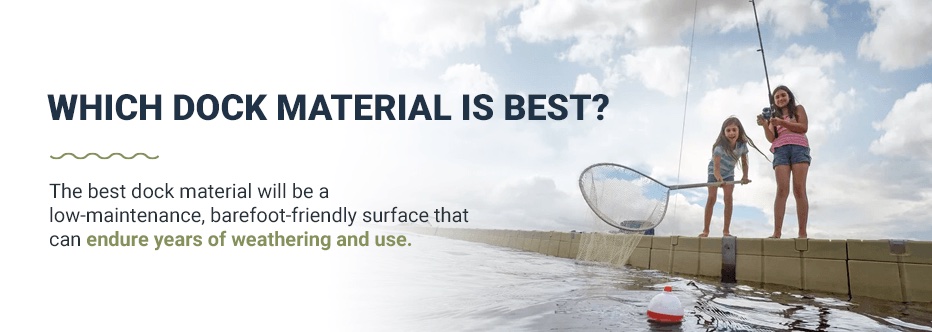
Whether you’re installing a new dock or remodeling an existing deck, chances are that you want a completed project that doesn’t require constant maintenance or repairs. High-quality materials that are durable and safe are important, but you also shouldn’t have to sacrifice appearance to retain benefits. Before you decide on a decking material, you should compare all options to determine the immediate and long-term benefits and drawbacks of each. The best dock material will be a low-maintenance, barefoot-friendly surface that can endure years of weathering and use.
Aluminum and wooden docks do feature a handful of benefits, but plastic docks are by far the most advantageous waterfront solutions. Both initial and overall costs for plastic decks are lower than other docking alternatives which helps you feel secure in your investment. They’re also easy to maintain, requiring limited upkeep in both fresh and saltwater environments. When shopping for a plastic dock, you should look for one that features a slip-resistant, eco-friendly surface that can be reconfigured, added on to or replaced when needed.
If you decide on a floating plastic dock, there’s no better option than EZ Dock — the ultimate waterfront solution. We are one of the top floating dock manufacturers in the world and have helped our customers design the perfect docking solutions for their homes, marinas, resorts, industrial applications, and government facilities. Lakeside, riverside and oceanside — wherever you need a dock, EZ Dock has you covered.
Our pioneering design uses recycled rubber couplings that allow each piece of the dock to move independently to keep the entire structure intact during the heaviest weather. These polyethylene docks are effortless to maintain in every environment. You’ll never need to repaint faded portions, replace rotted sections or repair splintered boards. Instead, our floating docks are designed to decrease time spent on maintenance while maximizing your time on the water.
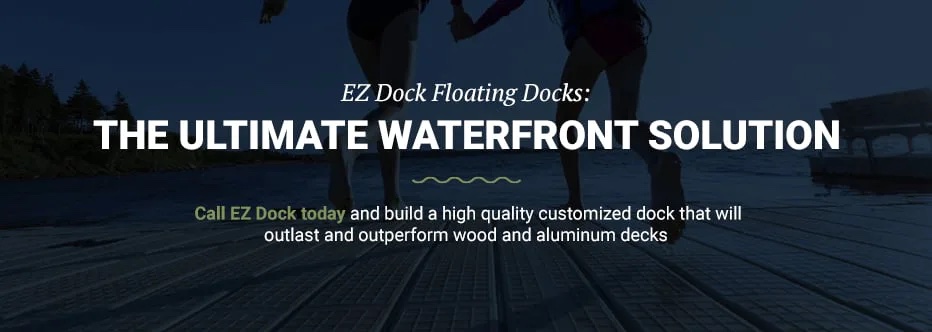
Just starting the dock research process? If you are ready for more information or would like an easy quote, contact EZ Dock Montana today and build a high-quality customized dock that is designed to both outlast and outperform wood and aluminum decks. With competitive pricing and the ability to customize, EZ Dock will enhance your outdoor experience like never before.
